 |
Indian Potato (Great Basin Orogenia, Turkey-peas),
Orogenia linearifolia
S. Wats. (right) The Indian potato grows in
the foothills and lower mountains of the Great Basin and elsewhere in the
Northwest. Orogenia is derived from two Greek words; oros means
“mountain” and genea means “race.” The species
name, linearifolia, refers to its narrow leaves. It is a small plant,
the umbels are only about a quarter of an inch across. Blooms develop when
thousands of plants emerge and flower simultaneously, always in soggy places,
as soon as the snow has melted in early spring. Common names, “Indian
potato” and “turkey peas” refer to peas-size edible roots
that may be eaten cooked or raw. Plant-hunter Sereno Watson (1826-1892)
discovered the umbellifers shown on this page while a member of the King
Expedition. |
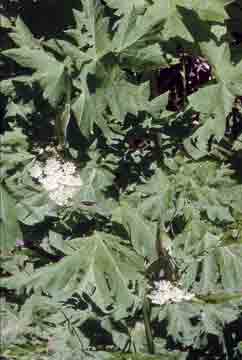 |
The Cow parsnip, Heracleum maximum
Bartr. (formerly Heracleum lanatum) is identified by
three-parted, coarsely toothed leaves that may grow to be a foot wide, and
by an inflorescence made up of numerous umbels that may be as large as the
leaves. Heracleum refers to Hercules who made use of related plants’
supposed medicinal properties. Not only are this plant’s leaves unusual
for their size (the largest of any American umbellifer), but the flowers
also are different from those of other Apiaceae, in that those on the margin
of the flowerhead are larger than the others, and their petals are sometimes
bilobed. The cow parsnip grows along stream lines, usually in the company
of alders, as high as the sub-alpine zone. The plants are said to be edible
if the furry stalks are skinned first.
|
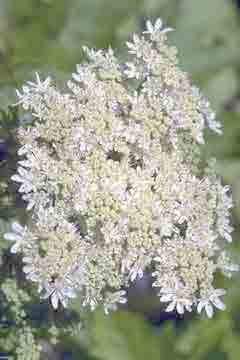 |
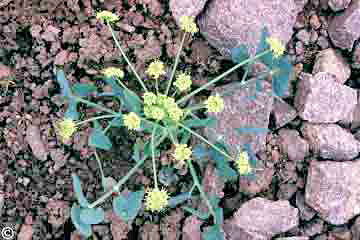 |
Biscuit roots: Lomatium spp.
Plants in several genera of Apiaceae are known as biscuit-roots including
species of Cymopterus and Lomatium (although the latter are
known more properly as "desert parsleys"). Although there are dozens of species,
we have chosen three lomatiums that are common in Idaho's mountains The roots
of all biscuit roots are more or less edible, and were so-used by Native
Americans. Exact species identification may require a guide book, but identifying
the plants generically as lomatiums should not be difficult, for they bloom
in early spring and have a characteristic appearance. Lomatium , from
the Greek, means “fringed,” referring to the appearance of the
fruit of some of the species.
The Bare-stemmed biscuit root, Lomatium
nudicaule (Pursh) Coult. & Rose
(left).The bare-stemmed lomatium (also “pestle parsnip”) grows
on gravelly slopes as high as tree-line. Lewis and Clark collected this plant
on April 15, 1806, in the vicinity of The Dalles in today’s Oregon.
Its species name, nudicaule, means, appropriately,
“bare-stemmed.” Native Americans reputedly used this plant to treat
consumption, and “Indian consumption root,” has been suggested
as a standardized common name.
The Nine-leaf lomatium, Lomatium
triternatum
(Pursh) Coult. & Rose (right).The nine-leaf
lomatium is so-named because each leaf divides into three narrow leaflets
that, in turn, divide into three more (triternatum, from the Latin,
means “three times three”). It blooms early in the spring on gravelly
slopes and meadows. Lewis and Clark collected all three of the lomatiums
shown on these pages and several others as well, during the expedition’s
return journey in the spring of 1806. None had previously been described,
not surprising for lomatiums are found only west of the Mississippi
River. Lewis and Clark, collected this plant along the banks
of Idaho’s Clearwater River on May 6, 1806. |
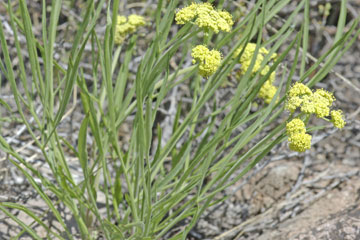 |
 |
The Fern-leaf Lomatium, Lomatium
dissectum (Nutt.) Mathias &
Constance: The fern-leaf desert-parsley, biscuit root, or lomatium--all
are in common use--is common. There are several varieties that differ in
appearance, but their identical, striped, pumpkin-seed-shaped fruit allows
them all to be placed in one species. Their divided leaves,
(dissectum means “divided into many lobes”) and their unusually
large size—they may be two feet or more tall—will help to
identify the plants as Lomatium dissectum; two varieties are shown
here. The yellow-flowered plant (right) is Lomatium dissectum
var. multifidum (Nutt.) Mathias & Constance. The varietal
name means “much divided.” The plant on the left is Lomatium
dissectum var. dissectum. Lewis and Clark collected
Lomatium dissectum on June 10, 1806, near today’s Kamiah, Idaho.
It can be seen there every spring, lining the walls of the Clearwater Canyon
.
|
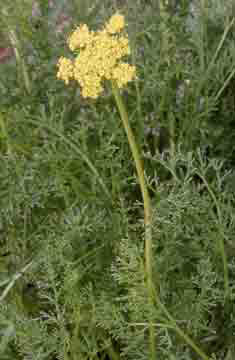
|






